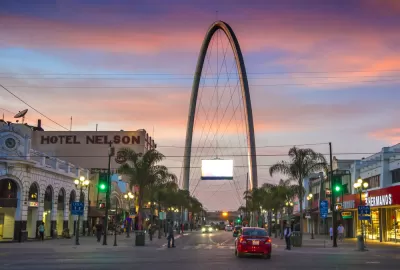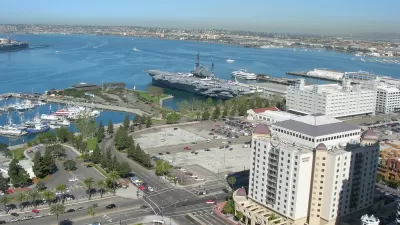On a recent tour of Tijuana for young land use professionals, San Diego architect Marin Gertler found a city that used the drought of U.S. tourism in the last decade to redefine and refine its urban core.

The combination of cartel violence and the U.S. recession were a one-two punch to the downtown Tijuana retail and restaurant economy. Long dependent on day tripper tourists and young American revelers, Tijuana was known primarily for its hawkers selling everything from tacky curios, to margaritas and beer, to more illicit goods and services—not to mention the tourists, many tacky themselves, who ambled or drunkenly stumbled down its streets.
The well publicized cartel violence, including some gun battles in Tijuana itself, deterred tourism. The recession, internet shopping, and long border waits all likely played a role too. Many Tijuana businesses, dependent on tourism, closed down, and the city's main tourist street, Avenida Revolucion, became a "ghost town of empty commercial spaces and former bars." However, this weaning from tourism (of the lowest variety) may have had a silver lining. On a recent tour put on by the Urban Land Institute San Diego/Tijuana Young Leader Partnership Forum, San Diego Gensler architect Marin Gertler found a revitalizing Tijuana urban core, not so dependent on tourism and catering more to young creatives—both local and from across the border. He writes about three stops on the tour that particularly inspired him. Find out more at the source article.
FULL STORY: Three great things happening now in downtown Tijuana, Baja California

Alabama: Trump Terminates Settlements for Black Communities Harmed By Raw Sewage
Trump deemed the landmark civil rights agreement “illegal DEI and environmental justice policy.”

Planetizen Federal Action Tracker
A weekly monitor of how Trump’s orders and actions are impacting planners and planning in America.

The 120 Year Old Tiny Home Villages That Sheltered San Francisco’s Earthquake Refugees
More than a century ago, San Francisco mobilized to house thousands of residents displaced by the 1906 earthquake. Could their strategy offer a model for the present?

In Both Crashes and Crime, Public Transportation is Far Safer than Driving
Contrary to popular assumptions, public transportation has far lower crash and crime rates than automobile travel. For safer communities, improve and encourage transit travel.

Report: Zoning Reforms Should Complement Nashville’s Ambitious Transit Plan
Without reform, restrictive zoning codes will limit the impact of the city’s planned transit expansion and could exclude some of the residents who depend on transit the most.

Judge Orders Release of Frozen IRA, IIJA Funding
The decision is a victory for environmental groups who charged that freezing funds for critical infrastructure and disaster response programs caused “real and irreparable harm” to communities.
Urban Design for Planners 1: Software Tools
This six-course series explores essential urban design concepts using open source software and equips planners with the tools they need to participate fully in the urban design process.
Planning for Universal Design
Learn the tools for implementing Universal Design in planning regulations.
Clanton & Associates, Inc.
Jessamine County Fiscal Court
Institute for Housing and Urban Development Studies (IHS)
City of Grandview
Harvard GSD Executive Education
Toledo-Lucas County Plan Commissions
Salt Lake City
NYU Wagner Graduate School of Public Service



























